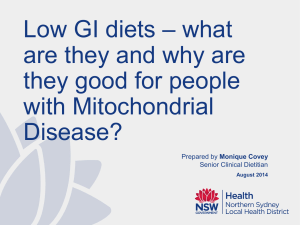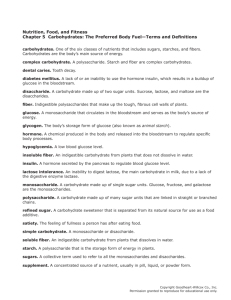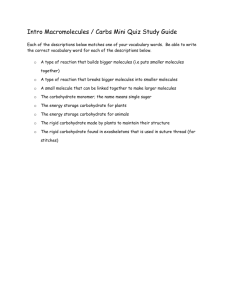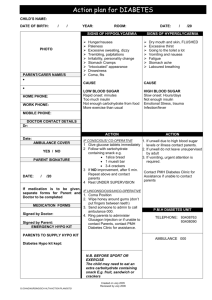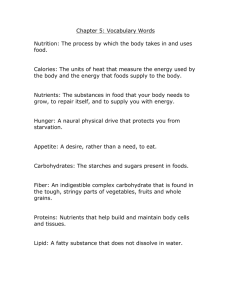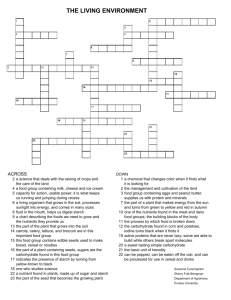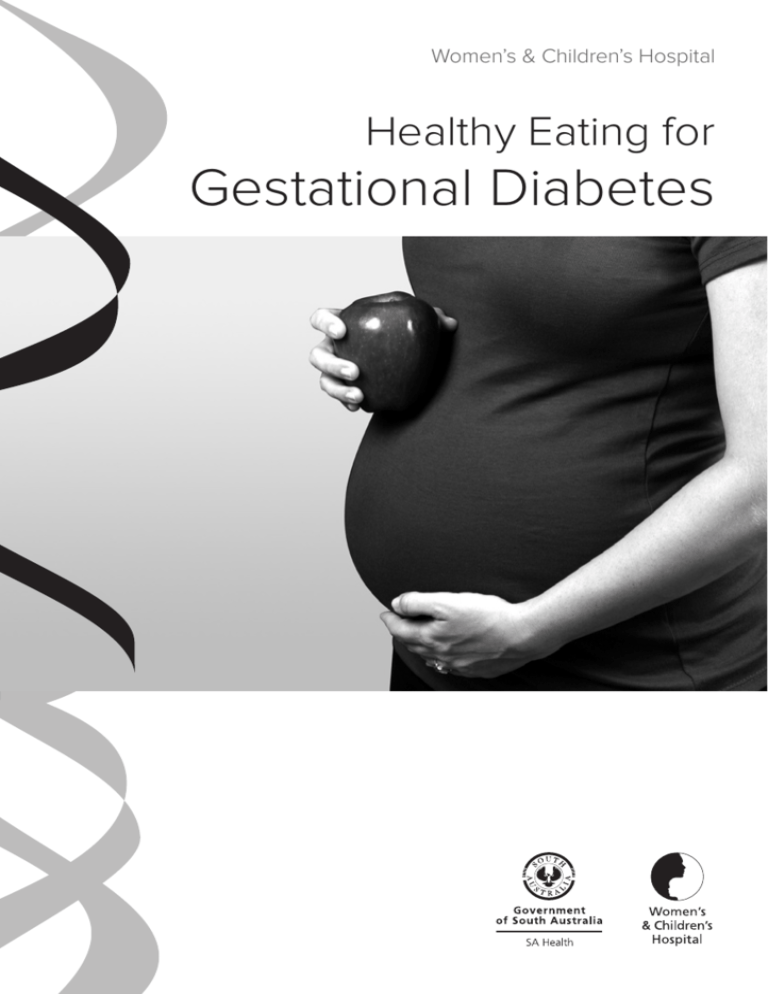
Women’s & Children’s Hospital
Healthy Eating for
Gestational Diabetes
Gestational Diabetes
Contents
1
What is Gestational Diabetes?
1
Why diet is important?
2
Healthy eating during pregnancy
4
Healthy eating when you have Gestational Diabetes
4
Carbohydrate foods
10
Label reading
12
‘Free’ foods
12
Artificial sweeteners
13
Fat
13
Protein
14
Physical activity
14
Medication and insulin
14
What happens after my baby is born?
15
Sample meal plan
16
Key points
17
More information
Gestational Diabetes
What is Gestational Diabetes?
Gestational Diabetes is diagnosed when high blood glucose (sugar) levels are found
during pregnancy. It is a temporary form of diabetes and usually goes away after the
baby is born.
Gestational Diabetes occurs when the hormones made by the placenta during pregnancy
stop insulin from working properly. Insulin is a hormone that allows glucose to pass from
the blood into the body’s cells where it can be used for energy. If insulin is not working
properly, then blood glucose will rise.
High blood glucose levels in the mother usually passes into the baby and can cause the
baby to grow bigger than normal. This may make delivery harder. It can also lead to low
blood glucose in your newborn baby. When gestational diabetes is well controlled, these
risks are greatly reduced.
This booklet provides you with information on healthy eating to help keep your blood
glucose within the normal range for the rest of your pregnancy. For most women this
can be done by:
>> following a healthy diet (as recommended for all pregnant women),
>> spreading your food intake over the day (particularly carbohydrate foods),
>> avoiding foods which contain large amounts of sugar,
>> checking blood glucose levels,
>> regular physical activity.
Why diet is important?
The most important part of treatment for gestational diabetes relates to food and your
eating pattern. Diet is important to:
>> meet the nutrition needs of you and your baby
>> help keep your blood glucose levels in the normal range and reduce problems
for your baby.
page 1
Healthy eating during pregnancy
It is important for women who are pregnant to eat a balanced diet. This will help your
baby to grow strong and healthy. When pregnant you need to meet your own nutritional
needs and also those of your baby. The types of food you eat is more important than the
amount of food. Calcium, iron, protein and folate are examples of nutrients which are
more important during pregnancy.
You can use the Australian Guide to Healthy Eating to help you understand what foods
you need. As shown in the diagram, foods are divided into five groups:
1.Bread, cereals, rice, pasta, noodles
2.Vegetables, legumes
3.Fruit
4.Milk, yoghurt, cheese
5.Meat, fish, poultry, eggs, nuts, legumes
Each group provides different nutrients. Try to choose a variety of foods from each of
the food groups.
Some foods do not fit into the five food groups. These are not essential for your body. These
‘extra’ foods, pictured outside the five food groups (bottom right corner) should be chosen
only sometimes or in small amounts. It is even more important to avoid or limit these foods
when you have gestational diabetes.
For more information on nutrition during pregnancy please refer to the SA Health booklet,
What should I eat? Nutrition for pregnancy and breastfeeding
– Women’s and Children’s Hospital.
www.wch.sa.gov.au/services/az/other/nutrition/nut_resources.html
page 2
Gestational Diabetes
page 3
Healthy eating when you have Gestational Diabetes
When you have gestational diabetes, large amounts of carbohydrate foods eaten at the
same time can cause high blood glucose levels. This is because carbohydrates are broken
down into glucose in your body. This glucose is used by the body as your main source
of energy.
To help prevent high blood glucose levels you will need to:
>> satisfy your hunger and maintain a healthy weight by eating small amounts often,
>> spread your intake of food evenly over the day. It is better to have three small meals
and three snacks than to eat three large meals.
The next few pages have more information on carbohydrate foods and how to eat well
to help prevent high blood glucose levels.
Carbohydrate foods
Many foods contain carbohydrates, for example bread, milk, fruit, lollies and soft drinks.
Which carbohydrate foods do I need to eat?
Healthy carbohydrate foods including:
>> Bread and breakfast cereals
>> Pasta, rice and noodles
>> Potato, sweet potato, corn
>> Legumes, such as baked beans, red kidney
beans and lentils
>> Fruit (fresh, dried, tinned, juice)
>> Milk, yoghurt, custard
It is important to eat these healthy carbohydrate foods as they are a good source of vitamins,
minerals, fibre and energy. These foods are important for you and your baby. They should
be eaten regularly throughout the day but need to be counted so that you do not eat
too much carbohydrate at once.
page 4
Gestational Diabetes
Which carbohydrate foods do I need to avoid?
High sugar carbohydrate foods including:
>> Regular soft drinks and cordial
>> Lollies, regular jelly
These high sugar carbohydrate foods should not be eaten
for the rest of your pregnancy. They will raise your blood
glucose levels very high, very quickly.
>> Table sugar
>> Jam, honey
Research shows that a small amount of these carbohydrate foods, as part of a healthy
eating plan, should not raise your blood glucose levels too much. Use only a half to one
teaspoon per main meal. When using these small amounts, these carbohydrate foods do
not need to be counted. It is best to avoid larger amounts, but if you do eat larger amounts
of these foods they must be counted as part of your carbohydrate serves for the day.
High fat carbohydrate foods including:
>> Sweet cakes and biscuits
>> Chocolate
>> Takeaway foods e.g. Pizza, burgers, chips, etc.
These high fat carbohydrate foods can be eaten sometimes, in small amounts only.
You will need to count these foods in your carbohydrate serves for the day.
page 5
How much carbohydrate?
Remember, large amounts of carbohydrate foods eaten at one time will cause the
blood glucose level to rise. This includes foods high in added sugar and also healthy
carbohydrate foods if too much is eaten at once. Spreading carbohydrate foods over the
day will help prevent this.
To help you to eat the right amount of carbohydrate, you can count the number of
carbohydrate serves that you eat during the day. As a guide, aim for about three serves at
each meal and one serve at each snack. A serve is approximately 15grams of carbohydrate.
2–3 carbohydrate serves at each meal
1–2 carbohydrate serves at each snack
1 serve = approximately 15 grams of carbohydrate
The foods listed in the tables on pages 8–9 all contain one serve of carbohydrate.
page 6
Gestational Diabetes
What type of carbohydrate?
All carbohydrate foods are broken down into glucose when eaten and will raise blood
glucose levels. However, different types raise the blood glucose levels at different rates.
The Glycemic Index (GI) of a food tells you how quickly and how high your blood
glucose levels rise after eating that food (see diagram below).
>> Foods with a low GI produce a slower, lower rise in blood glucose levels.
>> Foods with a high GI produce a fast, high rise in blood glucose levels.
>> Low GI foods will help to keep you fuller for longer.
Aim to include 1 low GI food at each meal.
The foods listed in the tables on pages 8–9 show you the low GI or better choices to
make when planning your meals and snacks.
For more information visit www.glycemicindex.com
High GI food
(e.g. jelly beans)
Low GI food
(e.g. baked beans)
Blood
Glucose
Level
Time (hours)
page 7
Breads and cereals
Carbohydrate serves (1 serve)
Better choices
Bread
>> Choose wholegrain/multigrain breads,
fruit bread or 'low GI' white breads.
>> 1 slice of bread or fruit bread
>> 1/2 bread roll
>> 1/2 english muffin
>> 1 round crumpet
Breakfast cereals
>> 1 1/2 Weetbix or Vita Brits
>> 1/4 cup oats, muesli, All Bran
>> 1/2 cup flake type cereal
Rice/pasta
>> 1/2 cup cooked pasta/noodles
>> 1/3 cup cooked rice or cous cous
Biscuits/crackers
>> 4 Vita-Weats
>> 6 water crackers/Jatz/Salada
>> 10 rice crackers/Sakatas
>> 2–3 plain sweet biscuits/Milk Coffee/
Digestives/Yo-Yo/Marie
>> 2 rice cakes
>> Choose wholegrain cereals e.g. porridge,
Weetbix, Vita Brits, Guardian, muesli,
All Bran.
>> Choose Basmati, Doongara or brown
rice as these are lower GI.
>> All types of pasta and noodles are
good choices.
>> Choose grainy crackers e.g. Vita-Weats
>> Choose higher fibre plain sweet biscuits
e.g. Digestives.
Milk and milk products
Carbohydrate serves (1 serve)
Better choices
>> 1 cup (250ml) milk/soy milk
>> Milk and milk products are low GI choices.
>> 1 tub (200g) natural yoghurt
>> Best choices are low fat varieties.
>> 1/2 tub (100g) fruit or flavoured yoghurt
>> 1 tub (200g) artificially sweetened
or ‘diet’ yoghurt
>> 1/2 cup (100ml) custard
>> 1 scoop plain ice-cream
>> 1 paddle pop
>> 6 squares plain milk chocolate
page 8
>> Ice-cream and chocolate should only
be eaten in small amounts.
Gestational Diabetes
Vegetables and legumes
Carbohydrate serves (1 serve)
Better choices
Vegetables
>> Choose sweet potato as it has a lower
GI than regular white potato.
>> 1 Potato (boiled/baked)
>> 1/2 cup mashed potato
>> 1 medium sweet potato, yam
>> 10–15 hot chips
>> 1/2 cup corn kernels
>> 1 small corn cob
>> Corn is low GI.
Legumes
>> All legumes are good choices and
are low GI.
>> 1/2 cup/small tin (130g) of baked beans
>> 2/3 cup cooked or canned kidney/
haricot beans, chickpeas
>> 3/4 cup cooked or canned lentils
Fruit
Carbohydrate serves (1 serve)
>> 1 medium apple, banana, peach,
pear, orange
>> 2 medium kiwifruit, mandarin,
or nectarine
>> 3 small apricots or plums
>> 1 1/2 cups watermelon, rockmelon or
honeydew melon
>> 20–25 grapes
>> 15–20 cherries
>> 3/4 cup of tinned fruit salad
(in natural juice, drained)
Better choices
>> Most fruits have a low GI and are good
choices, but limit to 1 serve at a time.
>> Choose fresh fruit instead of fruit juice.
>> 6 dried apricot halves
>> 1 tablespoon sultanas/raisins
>> 150ml apple juice
>> 200ml orange juice (unsweetened)
page 9
Label reading
Reading food labels is useful for working out the carbohydrate serves of foods not listed
in this booklet.
Nutrition Information Panel
Muesli
NUTRITION INFORMATION
Serving Size: 50g (3/4cup)
Energy
Protein
Fat
Carbohydrate
Total
Sugars
Dietary Fibre
Sodium
Per Serve (50g)
Per 100g
890kJ
4.5g
7.8g
1780kJ
9g
15.6g
28.8g
14.2g
4.3g
60mg
57.6g
28.4g
8.6g
120mg
INGREDIENTS: Cereals (49%) [wheat, oats], fruit (17%) [apricot, apple, raisins, sultanas,
cranberries], seeds and nuts (16%) [almonds, pepitas, cashews, hazelnuts, coconut],
raw sugar, honey, sunola oil, Maltodextrin, cinnamon, minerals (calcium), emulsifier (471),
vitamins (natural Vitamin E, Folate.
Carbohydrate
>> Total = all carbohydrate including sugars.
>> Sugars = indicates how much of the total carbohydrate comes from sugars.
Sugars will include all added sugars as well as naturally occurring sugars.
Fruit and milk contain naturally occurring sugars.
page 10
Gestational Diabetes
Working out carbohydrate serves from a label
On the Nutrition Information Panel, look at Total Carbohydrate in the per serve column.
Remember, one serve is about 15 grams of carbohydrate so to work out the number of
carbohydrate serves, use this guide:
5–10g total carbohydrate = ½ serve
11–19g total carbohydrate = 1 serve
20–25g total carbohydrate = 1½ serves
26–34g total carbohydrate = 2 serves
In the Muesli example (page 10):
3/4cup of muesli =……..... g of carbohydrate =……..... serves.
page 11
‘Free’ foods
The foods below have very little or no carbohydrate. These can be eaten freely without
affecting your blood glucose levels.
>> All salads and vegetables (except potato, corn, sweet potato and legumes).
>> Fruit – lemon, lime, passionfruit, rhubarb or small serve of berries.
>> Herbs, spices and sauces used in cooking.
>> Drinks – water, soda water, small amounts of diet cordial/soft drink, tea and coffee.
Remember:
>> Avoid foods with a higher risk of listeria.
>> Tea, coffee and cola drinks contain caffeine. Large amounts of caffeine can harm
your baby. It is best to drink no more than two to three cups of tea, coffee or cola
drinks a day.
For more information on nutrition during pregnancy please refer to the SA Health booklet,
What should I eat? Nutrition for pregnancy and breastfeeding
– Women’s and Children’s Hospital.
www.wch.sa.gov.au/services/az/other/nutrition/nut_resources.html
Artificial sweeteners
Artificial sweeteners are found in diet food products, e.g. diet cordial/soft drink, sugar
free lollies. They can be used safely in small amounts during pregnancy.
Research shows that a small amount of table sugar as part of a healthy eating plan should
not raise your blood glucose levels too much. If using table sugar instead or artificial
sweetener it is best to use a small amount only i.e. a half to one teaspoon of sugar as part
of each main meal.
page 12
Gestational Diabetes
Fat
While fat does not directly affect your blood glucose levels, if eaten in large amounts it
can cause extra weight gain. This may be hard to lose once the baby is born and may also
make controlling your blood glucose level harder.
A few tips:
>> Limit the amount of fat you eat, in particular
saturated fat (butter, fatty meats, pastries).
>> Use small amounts of ‘healthy’ fats such as canola,
olive, or sunflower oils, and polyunsaturated
margarines.
>> Choose lean meats and remove skin from chicken.
>> Choose low fat dairy products.
>> Limit takeaway food.
Protein
Protein is needed for the growth of your baby and your body’s own needs. Good protein
foods include lean meat, skinless chicken, fish, eggs, reduced fat cheese and nuts.
These foods will not directly affect your blood glucose levels.
Legumes are a part of this group, but they also contain carbohydrate, so they will need to
be counted in your carbohydrate serves.
A little extra protein is needed in the second half of your pregnancy. Most people will eat
more protein than they need, so having a protein food at lunch and dinner each day will
easily meet your needs.
Remember:
>> Avoid foods with a higher risk of listeria.
For more information on nutrition during pregnancy please refer to the SA Health booklet,
What should I eat? Nutrition for pregnancy and breastfeeding
– Women’s and Children’s Hospital.
www.wch.sa.gov.au/services/az/other/nutrition/nut_resources.html
page 13
Physical activity
Regular activity is an important part of a healthy lifestyle and healthy pregnancy.
Moderate activity (meaning a slight but noticeable increase in your breathing and heart
rate) can help with your blood glucose control, e.g. walking/swimming.
Pregnancy is not the time to begin a tough new exercise regime.
Remember:
>> Always check with your doctor if you are not sure before you start an exercise program.
Medication and insulin
Gestational diabetes is usually managed with healthy eating, regular physical activity
and blood glucose monitoring. Some women’s bodies require a little extra help to manage
blood glucose levels. Medication, such as tablets or insulin injections, may be needed.
Your doctor will review this and let you know if this is needed.
Remember:
>> If your doctor starts you on medication, it is still important to eat a healthy diet and
continue with regular physical activity.
What happens after my baby is born?
Usually, blood glucose returns to normal within six weeks after birth. Your doctor will
check your blood glucose after your baby is born to make sure it has returned to normal.
Women who have had gestational diabetes during one pregnancy have a higher chance
of developing gestational diabetes in the next pregnancy. In addition, women who have
had gestational diabetes are much more likely to develop type 2 diabetes later in life.
To help delay or even prevent the development of type 2 diabetes it is important for you to:
>> have regular checks for diabetes in the following years
>> maintain a healthy weight
>> encourage the whole family to enjoy a healthy diet and healthy lifestyle.
page 14
Gestational Diabetes
Sample meal plan
Note: this is a sample meal plan only. Use tables on pages 8–9 to develop your own meal plan.
Breakfast (all 2–3 carbohydrate serves)
>> 1 cup special K/ 2 Weetbix/ 1/2 cup muesli >> 2 slices wholegrain toast with toppings
(2 serves) with 1 cup skim milk (1 serve)
(2 serves)
>> 1 English muffin (2 serves) with 1/2 cup
baked beans (1 serve) and 1 egg
>> 200g low fat yoghurt (2 serves) with
3/4 cup of tinned fruit in natural juice
(drained) (1 serve)
Lunch (all 2–3 carbohydrate serves)
>> 1 wholegrain sandwich/roll/wrap (2 serves)
with egg/tuna/low fat cheese + salad
>> 1 cup of lentil soup (1 serve) with 2
slices of wholegrain bread (2 serves)
>> 2/3 cup of basmati rice (2 serves) with
>> 4 Vita-Weats (1 serve) with 1 small tin
2/3 cup beans (1 serve) or 3/4 cup lentils
tuna and 1 piece of fruit (1 serve)
(1 serve) or lean meat/fish/chicken (100g)
and salad/vegetables (other than potato
and corn)
Dinner (all 2–3 carbohydrate serves)
>> 100g lean meat/chicken/fish with 1 boiled >> 11/2 cups cooked pasta (3 serves) with
potato (1 serve), 1/2 cup corn (1 serve)
tomato based sauce and garden salad
and a side of other vegetables/salad
>> 1 cup basmati rice (3 serves) with stir
fried lean chicken/beef/fish (100g) and
vegetables (other than potato and corn)
>> 2 tortillas (2 serves) with lean mince
and salad followed by 1/2 cup low fat
custard (1 serve)
Morning tea/ afternoon tea/ snacks (all 1–2 carbohydrate serves)
>> 1 medium piece of fruit (1 serve)
>> 200g low fat yoghurt (2 serves)
>> 4 Vita-Weats (1 serve) with low fat
cream cheese
>> 1 slice fruit toast (1 serve) with thin
scrape of margerine
>> 1 cup skim milk (1 serve)
>> 2 Digestives biscuits (1 serve)
>> 200ml skim milk with 2 tsp milo/nesquik >> 10 rice crackers (e.g. sakatas) with
(1 serve)
low fat dip
page 15
Key points
>> Good nutrition for gestational diabetes includes the same foods as with any pregnancy.
>> Be aware of your carbohydrate foods including how many serves you are eating.
>> Make sure you eat carbohydrate foods regularly throughout the day and don’t skip meals.
>> Avoid high sugar foods.
>> Include low Glycemic Index (GI) foods.
>> Regular physical activity is helpful in controlling blood glucose.
page 16
More information
Women’s and Children’s Hospital
>> Nutrition for pregnancy and breastfeeding resource
www.wch.sa.gov.au/services/az/other/nutrition/nut_resources.html
Children, Youth and Women’s Health Service (CYWHS)
>> Parenting and Child Health – Health Topics – Diabetes in pregnancy
www.cyh.com/HealthTopics/HealthTopicDetails.aspx?p=114&np=304&id=1576
>> Pregnancy – Pregnancy Topics – Gestational diabetes
www.cyh.com/HealthTopics/HealthTopicDetails.aspx?p=438&np=462&id=2784
Diabetes Australia
Phone: 1300 136 588
>> www.diabetesaustralia.com.au/en/Living-with-Diabetes/Gestational-Diabetes/
>> www.diabetesaustralia.com.au/PageFiles/1419/GLYCAEMIC_INDEX.pdf
>> www.diabetesaustralia.com.au/PageFiles/1419/HEALTHY_EATING_GESTATIONAL.pdf
Diabetes ACT
>> www.diabetes-act.com.au/UserFiles/File/fact_sheets/16_Gestational_diabetes.pdf
>> www.diabetes-act.com.au/UserFiles/File/fact_sheets/19_Healthy_eating_gestational.pdf
>> www.diabetes-act.com.au/UserFiles/File/fact_sheets/17_Glycemic_Index.pdf
Diabetes Outreach Country Health SA
>> www.diabetesoutreach.org.au
Dietitians Association of Australia (DAA)
>> www.daa.asn.au
Notes
The original nutritional and educational content of this booklet has
been reviewed by specialist Dietitians at the Children, Youth and
Women’s Health Service (CYWHS), SA Health. Information in this
booklet should not be used as an alternative to professional advice.
Food product information contained in this booklet was up to date
at the time of revision. If you are not sure about a food, check with
the manufacturer.
Produced by
Children, Youth and
Women’s Health Service
Nutrition Department
72 King William Road
North Adelaide SA 5006
Phone (08) 8161 7233
Non-English speaking: for information in languages other than
English, call the interpreting and Translating Centre and ask them
to call The Department of Health. This service is available at no
cost to you, contact (08) 8226 1990.
http://www.gilf.gov.au/
© Department of Health, Government of South Australia.
All rights reserved. Revised February 2011. Printed February 2011.

